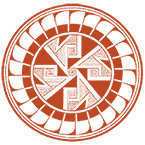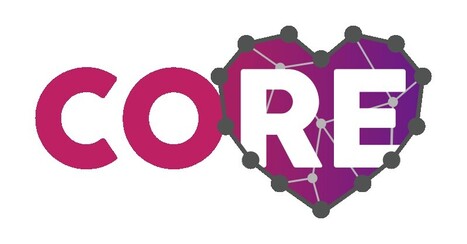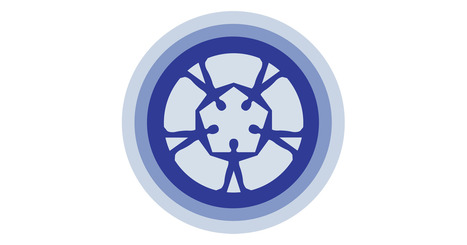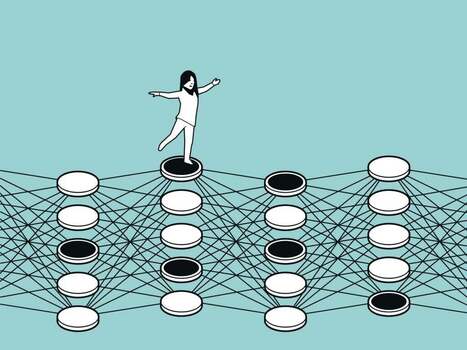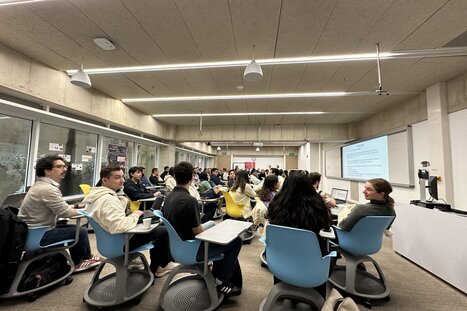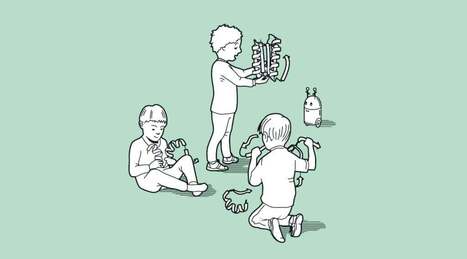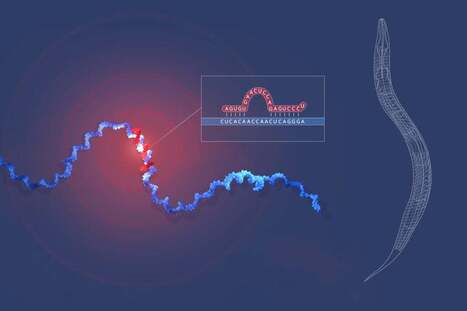 Your new post is loading...
 Your new post is loading...
The Max Planck – University of Helsinki Center for Social Inequalities in Population Health is currently seeking to appoint one or more full-time post-doctoral researchers. We welcome applications from researchers with a PhD in demography, sociology, statistics, epidemiology, public health, biology, anthropology, economics, computer science, and allied fields. The successful candidate(s) will work on the role of genetic factors in shaping health inequalities, and/or they will develop novel techniques for leveraging genetic data. We are also open to applicants interested in the other research themes of the Center (family and health, health inequalities in an international perspective), and in other topics covered in the Department Social Demography at the Max Planck Institute for Demographic Research (MPIDR), including fertility, mortality and morbidity, and labor markets. The successful candidate(s) will develop their own agenda within the Center, and they will contribute their skills and knowledge to other projects in the Center and to the MPIDR. We are seeking creative, self-driven, and collaborative scholars. Advanced knowledge of quantitative methods and statistical software such as R, Python, or Stata is required. Read the full call at: www.demogr.mpg.de

|
Scooped by
Complexity Digest
August 6, 3:38 AM
|
The Santa Fe Institute is now accepting applications for the 2026 Complexity Postdoctoral Fellowships! Complexity fellows contribute to SFI’s research and collaborate with leading researchers worldwide. If you recently completed your PhD in any scientific discipline and are interested in transdisciplinary research, consider applying. SFI offers independent research opportunities and support to explore big questions across disciplines.

|
Scooped by
Complexity Digest
March 5, 10:36 AM
|
Submission Deadlines:
Abstracts: 01 April 2025
Full Papers: 01 August 2025
Publication: March-April 2026 Cybernetics and systems education have long played a vital role in understanding complex, purposeful and adaptive systems. With the advent of next generation artificial intelligence and with the vast range of complex socio-technical systems that require collective transformation, cybernetic and systems principles have only become more relevant. There is a growing, transnational need for education programs to prepare the current and next generation to operate within and beyond these frameworks. This special issue seeks to bring together educators, researchers and practitioners to explore the past, present, and future of cybernetics and systems education. We aim to examine how cybernetic concepts and systems thinking have been previously and/or are currently integrated into educational paradigms, showcase novel approaches to teaching these principles, and envision transformative methodologies that may shape the future of cybernetics and systems education. Through this special issue we seek to create and promote a transnational network to further cybernetic and cybernetically informed systems education. Read the full article at: onlinelibrary.wiley.com

|
Scooped by
Complexity Digest
March 2, 9:45 PM
|
Complexity and Networks COmmunity and REsources (CORE) is an organization dedicated to connecting scientists and organizations in the fields of Complexity and Network Science. We enhance collaboration among organizations that organize talks, seminars, and events, and we collect all conference and job application deadlines to create a hub where scientists can find relevant news and information. On this page, you will find information about the organizations and contributors involved in this project. CORE Members: NetPlace, yrCSS, WiNS, Complexity Cat, WWCS, Complexity72h. More at: complexity-core.github.io

|
Scooped by
Complexity Digest
February 23, 9:28 PM
|
The scientific community is increasingly aware of the profound challenges associated with research evaluation, particularly the reliance on quantitative journal metrics such as the impact factor as proxies for scientific quality. These practices have entrenched a system where researchers are compelled to publish in high-cost, high-impact journals to advance their careers, often at the expense of broader scientific contributions. Despite the growing adoption of initiatives like DORA (https://sfdora.org), Plan S (https://www.coalition-s.org), CoARA (https://coara.eu), or PEER Community (https://peercommunityin.org), which aim to reform research assessment and promote open science, progress has been slow, and deeply-ingrained evaluation schemes still dominate. Thus, initiatives that support dissemination of knowledge (outreach, extension), data curation and sharing, research in non-academic contexts (which is more “messy”, difficult to conduct) and in response to real-world needs and with impact is not sufficiently valued. These issues are compounded by the dominance of commercial publishers, whose exorbitant article processing charges (APCs) and profit-driven models exploit the academic community creating inequalities, fostering an unsustainable and unfair publishing system that threatens the very preservation and dissemination of scholarly knowledge. Read the full article at: cssociety.org

|
Scooped by
Complexity Digest
February 2, 4:45 PM
|

|
Scooped by
Complexity Digest
January 28, 3:40 PM
|
The Complex Systems Seminar Series covers a wide range of topics, providing an opportunity for presenters to share and attendees to become exposed to the latest research from different fields and disciplines.
Agent-based simulation, artificial intelligence, artificial life, genetic algorithms, machine learning, neural networks, signal processing, social networks, system dynamics, and science itself are just a few of the many diverse topics that have been presented, all in an informal environment where questions and discussion are encouraged. Schedule at: www.pdx.edu

|
Scooped by
Complexity Digest
January 5, 5:10 PM
|
The CCS is the flagship annual meeting for the complex systems research community, operating within the framework of the Complex Systems Society. This special 21st anniversary conference is organized within the University of Siena (Siena, Italy), in the magnificent Unesco Heritage City of Siena. Previous editions took place in London/Exeter 2024, Salvador de Bahia 2023, Palma de Mallorca 2022,Lyon 2021, Online 2020, Singapore 2019, Thessaloniki 2018 and Cancun 2017. More at: www.congressi.unisi.it

|
Scooped by
Complexity Digest
December 4, 2024 2:43 PM
|
Explore the world of complexity science with NECSI’s Winter Session 2025. This specially designed course offers an in-depth understanding of complex systems, combining theoretical foundations with real-world applications. Whether you aim to deepen your expertise or begin a new intellectual journey, this program provides a comprehensive and academically rigorous exploration of the field.
Course Dates: 10-21 February 2025
Details at: necsi.edu

|
Scooped by
Complexity Digest
October 31, 2024 4:52 PM
|
Do you have a great research idea but need the right people to bring it to life? Help us make Complexity72h an unforgettable experience again by applying to be a tutor in Madrid next June. The call for tutors is now open!
We’re looking for project proposals from experienced researchers to be developed over 72 hours by a team of 6-8 workshop participants.
Deadline for Call for Tutors: January 7th, 2025
More at: complexity72h.com

|
Scooped by
Complexity Digest
October 14, 2024 12:54 PM
|
When Europeans colonised large parts of the globe, the institutions in those societies changed. This was sometimes dramatic, but did not occur in the same way everywhere. In some places the aim was to exploit the indigenous population and extract resources for the colonisers’ benefit. In others, the colonisers formed inclusive political and economic systems for the long-term benefit of European migrants.
The laureates have shown that one explanation for differences in countries’ prosperity is the societal institutions that were introduced during colonisation. Inclusive institutions were often introduced in countries that were poor when they were colonised, over time resulting in a generally prosperous population. This is an important reason for why former colonies that were once rich are now poor, and vice versa.
Some countries become trapped in a situation with extractive institutions and low economic growth. The introduction of inclusive institutions would create long-term benefits for everyone, but extractive institutions provide short-term gains for the people in power. As long as the political system guarantees they will remain in control, no one will trust their promises of future economic reforms. According to the laureates, this is why no improvement occurs.
However, this inability to make credible promises of positive change can also explain why democratisation sometimes occurs. When there is a threat of revolution, the people in power face a dilemma. They would prefer to remain in power and try to placate the masses by promising economic reforms, but the population are unlikely to believe that they will not return to the old system as soon as the situation settles down. In the end, the only option may be to transfer power and establish democracy.
“Reducing the vast differences in income between countries is one of our time’s greatest challenges. The laureates have demonstrated the importance of societal institutions for achieving this,” says Jakob Svensson, Chair of the Committee for the Prize in Economic Sciences.
Read the full article at: www.nobelprize.org

|
Scooped by
Complexity Digest
October 8, 2024 1:37 PM
|
When we talk about artificial intelligence, we often mean machine learning using artificial neural networks. This technology was originally inspired by the structure of the brain. In an artificial neural network, the brain’s neurons are represented by nodes that have different values. These nodes influence each other through connections that can be likened to synapses and which can be made stronger or weaker. The network is trained, for example by developing stronger connections between nodes with simultaneously high values. This year’s laureates have conducted important work with artificial neural networks from the 1980s onward.
John Hopfield invented a network that uses a method for saving and recreating patterns. We can imagine the nodes as pixels. The Hopfield network utilises physics that describes a material’s characteristics due to its atomic spin – a property that makes each atom a tiny magnet. The network as a whole is described in a manner equivalent to the energy in the spin system found in physics, and is trained by finding values for the connections between the nodes so that the saved images have low energy. When the Hopfield network is fed a distorted or incomplete image, it methodically works through the nodes and updates their values so the network’s energy falls. The network thus works stepwise to find the saved image that is most like the imperfect one it was fed with.
Geoffrey Hinton used the Hopfield network as the foundation for a new network that uses a different method: the Boltzmann machine. This can learn to recognise characteristic elements in a given type of data. Hinton used tools from statistical physics, the science of systems built from many similar components. The machine is trained by feeding it examples that are very likely to arise when the machine is run. The Boltzmann machine can be used to classify images or create new examples of the type of pattern on which it was trained. Hinton has built upon this work, helping initiate the current explosive development of machine learning. Read the full article at: www.nobelprize.org

|
Scooped by
Complexity Digest
September 26, 2024 12:51 PM
|
The Complex Systems Society (CSS) organizes every year a main conference (CCS) — the most important annual meeting for the complex systems research community.
The Complex Systems Society invites bids to host the 2026 and 2027 editions.
The conference is generally held in September/October of each year.
More at: cssociety.org
|

|
Scooped by
Complexity Digest
September 10, 9:29 AM
|
The Evolving Landscape of Complex Systems is a curated special collection in npj Complexity inspired by themes explored at the Conference on Complex Systems 2025 (CCS25). This collection consolidates emerging advances in theory, methodologies, and applications across the multifaceted area of complexity science. It seeks contributions that span the full spectrum - from novel computational frameworks and multiscale analyses to domain-adaptive models and novel complexity science applications - reflecting the discipline’s rapid evolution.
This collection invites novel research that explores:
Conceptual foundations and theory: advancements in network science, emergent dynamics, agent-based modelling, nonlinear systems, and adaptive behaviours, providing refined lenses for interpreting complex phenomena.
Cross-scale integration and robustness: studies elucidating how micro-level interactions scale up to macro-level patterns, resilience, and adaptation in systems spanning biological, social, technological, and ecological networks.
Computational innovation: cutting-edge analytical and computational methods - ranging from data-driven approaches and AI-augmented modelling to novel simulations and multilevel inference - that enhance the understanding and manipulation of complex systems.
Interdisciplinary and application-oriented research: compelling case studies where complexity science addresses urgent global challenges - such as pandemics, misinformation, climate change, socioeconomic inequality, inclusivity and diversity, and governance - demonstrating adaptability and societal relevance.
Submissions are welcomed from all researchers working in complexity science, regardless of conference participation. More at: www.nature.com

|
Scooped by
Complexity Digest
April 10, 10:40 AM
|
For decades Hiroki Sayama has sought to achieve what a century ago would have been mere science fiction—creating life on our computers. Read the full article at: amahury.github.io

|
Scooped by
Complexity Digest
March 5, 10:10 AM
|
The goal of this course is to help produce a community of leaders that is equally knowledgeable in neuroscience, cognitive science, and computer science and will lead the scientific understanding of intelligence and the development of true biologically inspired AI. Course/Program Dates:
Aug 03, 2025 - Aug 24, 2025
Application due date:
Mar 24, 2025 The basis of intelligence – how the brain produces intelligent behavior and how to endow machines with human-like intelligence – is arguably the greatest problem in science and technology. To solve it, we will need to understand how natural intelligence emerges from computations in neural circuits, with rigor sufficient to reproduce similar intelligent behavior in machines. Success in this endeavor will ultimately enable us to understand ourselves better, to produce smarter machines, and perhaps even to make ourselves smarter. Today’s AI technologies are impressive but quite different from human intelligence. We still do not understand the mechanisms underlying the robustness, the generalization, and the continual learning capabilities of biological intelligence. The synergistic combination of cognitive science, neurobiology, engineering, mathematics, and computer science holds the promise of significant progress. Elucidating how human intelligence works will in turn lead to more sophisticated AI algorithms. The goal of this course is to help produce a community of leaders that is equally knowledgeable in neuroscience, cognitive science, and computer science and will lead the scientific understanding of intelligence and the development of true biologically inspired AI. Apply at: www.mbl.edu

|
Scooped by
Complexity Digest
February 25, 2:28 PM
|
EPJ Data Science Submission deadline 31 July 2025 Digital, information and communication technologies, together with Big Data, the Internet of Things, and Artificial Intelligence, are reshaping almost every aspect of our societies. From traffic to logistics, from mobility to smart cities and societies, much of this gears towards more predictability, controllability, and automation, using digital twins and many other approaches. Optimizing performance, sustainability, resilience, and health are often stated goals. But what roles will complexity and collective intelligence, democracy and human rights, ethics, agency and freedom, co-creation and co-evolution play? And how can scientific disciplines – from data science and complexity theory to computational social science, network analysis, transportation modeling, game theory, and agent-based as well as AI-driven models – contribute to understanding these challenges and to shaping future solutions? This special collection seeks to reflect on recent advances in these fields and explore visions for the future. It will provide a platform for critical reflection on the scientific methodologies and technological strategies currently driving our world. We invite inspiring contributions that provoke innovative thoughts and stimulate rigorous debate on the future trajectory of these technologies and the socio-technical systems that are expected to result from them. Submit at: link.springer.com

|
Scooped by
Complexity Digest
February 3, 2:26 PM
|
Applications for the third Complexity Global School (CGS) are now open. Like last year, the school will be hosted at Universidad de los Andes (Uniandes), in Bogotá, Colombia, but for the first time, applicants from all countries are eligible to apply. Roughly 60 students will be selected for the school, which will run July 28 – August 8, 2025. Supported by the Omidyar Network and the Ford Foundation, the school is free for all admitted students — tuition, room, board, and a travel stipend are included. Applications are due by March 2, 2025. Apply at: www.santafe.edu

|
Scooped by
Complexity Digest
January 29, 11:24 AM
|
Ole Teutloff, Johanna Einsiedler, Otto Kässi, Fabian Braesemann, Pamela Mishkin, R. Maria del Rio-Chanona Journal of Economic Behavior & Organization We examine how ChatGPT has changed the demand for freelancers in jobs where generative AI tools can act as substitutes or complements to human labor. Using BERTopic we partition job postings from a leading online freelancing platform into 116 fine-grained skill clusters and with GPT-4o we classify them as substitutable, complementary or unaffected by LLMs. Our analysis reveals that labor demand increased after the launch of ChatGPT, but only in skill clusters that were complementary to or unaffected by the AI tool. In contrast, demand for substitutable skills, such as writing and translation, decreased by 20–50% relative to the counterfactual trend, with the sharpest decline observed for short-term (1-3 week) jobs. Within complementary skill clusters, the results are mixed: demand for machine learning programming grew by 24%, and demand for AI-powered chatbot development nearly tripled, while demand for novice workers declined in general. This result suggests a shift toward more specialized expertise for freelancers rather than uniform growth across all complementary areas. Read the full article at: www.sciencedirect.com

|
Scooped by
Complexity Digest
January 9, 1:01 PM
|
Robert Rosen was a leading theoretical biologist in the tradition of relational biology, making important contributions to the understanding of living systems. We believe that Robert Rosen’s work represents valuable perspectives on biology, causality, and science as a whole, and that it deserves to be more widely known and read. Over the last four years, we have taken care in classifying his complete published works, including articles, chapters, commentaries, and books both in and out of print, and most importantly, scanning and sorting a small part of his vast collection of unedited notes, which contain ideas that extend beyond his published works. Our hope is that interested readers will find a foundation here for a new science of biological systems, one that reflects the nature and complexity of these systems. Visit: www.rosenlife.org

|
Scooped by
Complexity Digest
December 18, 2024 9:22 AM
|
To celebrate 20 years since the launch of Journal of the Royal Society Interface, we are launching a Perspective competition. The winner will receive a prize of £1,000. More at: royalsociety.org

|
Scooped by
Complexity Digest
November 26, 2024 5:16 PM
|
The University of Klagenfurt is pleased to announce the following open position at the Department of Business Management at the Faculty of Management, Economics & Law with a negotiable starting date, commencing on March 3, 2025, at the latest:
University assistant predoctoral (all genders welcome)
Level of employment: 75 % (30 hours/week)
Minimum salary: € 37,577.40 per annum (gross); classification according to collective agreement: B1
Contract duration: 3.5 years
Application deadline: January 8, 2025
Area of responsibility
* Research in a project for studying Self-Fulfilling Prophecies from the perspective of complex systems and management control, emphasizing the impact of digital technologies
* Independent scientific work with the aim to submit a dissertation and acquire a Doctoral degree
* Teaching and student supervision in the domain of the project
* Engagement in networking and science communication Apply at: jobs.aau.at
The Max Planck Institute for Demographic Research (MPIDR) is recruiting highly qualified Post-Docs or Research Scientists to join the Department of Digital and Computational Demography, headed by MPIDR Director Emilio Zagheni. The positions will be filled in the Lab of Migration and Mobility and/or in the Lab of Population Dynamics and Sustainable Well-Being. Digital and computational demography is a growing interdisciplinary field that tackles fundamental questions across all domains of demographic research by combining the methods and perspectives of computational sciences, social and behavioral sciences, and statistics. The field has emerged in parallel with rapid technological improvements in computing, the spread of Internet and mobile technologies, and the increased digitalization of people’s lives. Our group brings together methodologists (from areas like statistics, computer science or formal demography) with experts in various areas of the social sciences in order to foster cross-pollination of ideas, to advance methods and theories of population research, and to address pressing scientific and societal questions. Candidates who can enrich or complement projects in any Research Area of the Lab of Migration and Mobility or of the Lab of Population Dynamics and Sustainable Well-Being will be considered. Across all profiles, ability and willingness to work in interdisciplinary teams in order to conduct cutting-edge research that advances our understanding of population processes is key. More at: www.demogr.mpg.de

|
Scooped by
Complexity Digest
October 9, 2024 9:43 AM
|
The diversity of life testifies to proteins’ amazing capacity as chemical tools. They control and drive all the chemical reactions that together are the basis of life. Proteins also function as hormones, signal substances, antibodies and the building blocks of different tissues.
“One of the discoveries being recognised this year concerns the construction of spectacular proteins. The other is about fulfilling a 50-year-old dream: predicting protein structures from their amino acid sequences. Both of these discoveries open up vast possibilities,” says Heiner Linke, Chair of the Nobel Committee for Chemistry.
Proteins generally consist of 20 different amino acids, which can be described as life’s building blocks. In 2003, David Baker succeeded in using these blocks to design a new protein that was unlike any other protein. Since then, his research group has produced one imaginative protein creation after another, including proteins that can be used as pharmaceuticals, vaccines, nanomaterials and tiny sensors.
The second discovery concerns the prediction of protein structures. In proteins, amino acids are linked together in long strings that fold up to make a three-dimensional structure, which is decisive for the protein’s function. Since the 1970s, researchers had tried to predict protein structures from amino acid sequences, but this was notoriously difficult. However, four years ago, there was a stunning breakthrough.
In 2020, Demis Hassabis and John Jumper presented an AI model called AlphaFold2. With its help, they have been able to predict the structure of virtually all the 200 million proteins that researchers have identified. Since their breakthrough, AlphaFold2 has been used by more than two million people from 190 countries. Among a myriad of scientific applications, researchers can now better understand antibiotic resistance and create images of enzymes that can decompose plastic.
Life could not exist without proteins. That we can now predict protein structures and design our own proteins confers the greatest benefit to humankind. Read the full article at: www.nobelprize.org

|
Scooped by
Complexity Digest
October 8, 2024 12:36 PM
|
The information stored within our chromosomes can be likened to an instruction manual for all cells in our body. Every cell contains the same chromosomes, so every cell contains exactly the same set of genes and exactly the same set of instructions. Yet, different cell types, such as muscle and nerve cells, have very distinct characteristics. How do these differences arise? The answer lies in gene regulation, which allows each cell to select only the relevant instructions. This ensures that only the correct set of genes is active in each cell type.
Victor Ambros and Gary Ruvkun were interested in how different cell types develop. They discovered microRNA, a new class of tiny RNA molecules that play a crucial role in gene regulation. Their groundbreaking discovery revealed a completely new principle of gene regulation that turned out to be essential for multicellular organisms, including humans. It is now known that the human genome codes for over one thousand microRNAs. Their surprising discovery revealed an entirely new dimension to gene regulation. MicroRNAs are proving to be fundamentally important for how organisms develop and function. Read the full article at: www.nobelprize.org
|



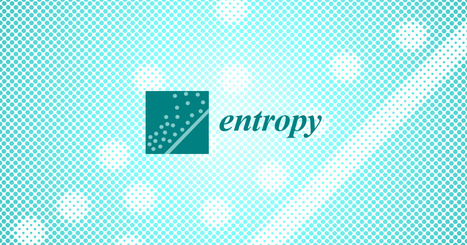


 Your new post is loading...
Your new post is loading...

